Birds
Media
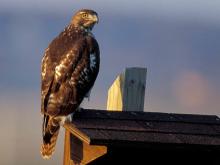
Species Types
Scientific Name
Buteo jamaicensis
Description
Adult red-tailed hawks are large, brown above, and white below, with a brown-streaked band on the belly and a rust-red tail with a narrow black band near the end. They are commonly seen along highways, watching for prey.
Media
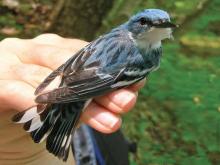
Species Types
Scientific Name
Setophaga cerulea (formerly Dendroica cerulea)
Description
A summer resident in Missouri, the cerulean warbler is more common in the southeastern Ozarks but rare elsewhere in the state. Its numbers are small and declining, and for that reason our nation may soon classify it as endangered.
Media
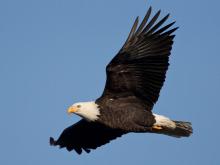
Species Types
Scientific Name
Haliaeetus leucocephalus
Description
Our national symbol, the mature bald eagle is unmistakable with its dark brown body, yellow bill, and white head and tail. It soars with wings held flat and can have a 7-foot wingspan.
Media

Species Types
Scientific Name
Aix sponsa
Description
The wood duck is one of the world's most beautiful waterfowl. It is equally famous for being a cavity nester in hollow trees, sometimes 60 feet above the ground and a mile away from water.
Media
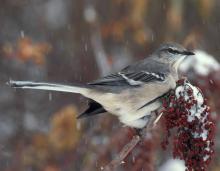
Species Types
Scientific Name
Mimus polyglottos
Description
One of the best-known U.S. songbirds, the northern mockingbird can sing endlessly, night and day, repeating phrases from the songs of other birds. Its white wing patches are conspicuous in flight.
Media
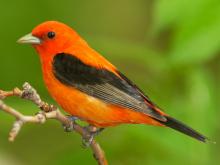
Species Types
Scientific Name
Piranga olivacea
Description
In summer, scarlet tanagers feed on insects and fruit in the canopy of oak-hickory forests and in large shade trees of the eastern U.S. and southern Canada.
Media

Species Types
Scientific Name
Piranga rubra
Description
Adult male summer tanagers are entirely red — an unforgettable sight as they forage for insects among bright green tree leaves in early summer.
Media

Species Types
Scientific Name
Sitta pusilla
Description
Years of planning have brought the brown-headed nuthatch back to the pine-woodlands of southern Missouri. Their calls sound like rubber duckies: squeaka squeaka! These tiny birds with chisel bills creep on pine branches.
Media

Species Types
Scientific Name
Sitta canadensis
Description
The red-breasted nuthatch is an uncommon winter resident in Missouri’s pine forests. It has rusty underparts and a bold white stripe above the black eye line. Its song is like the white-breasted-nuthatch’s but is higher-pitched: “wak, wak, wak, wak, wak.”
Media

Species Types
Scientific Name
Ictinia mississippiensis
Description
The Mississippi kite is a rare summer resident in Missouri, usually seen flying above forests and grasslands along the Mississippi River valley. The flight of this rather small raptor is buoyant, like that of a swallow, or, yes, a kite.
See Also







Media

Species Types
Scientific Name
Hemaris diffinis
Description
The snowberry clearwing is a moth that confuses people because it looks like a bumblebee and flies like a hummingbird!
Media

Species Types
Scientific Name
Hyles lineata
Description
The white-lined sphinx moth sometimes confuses people because it flies, hovers, and eats from flowers like a hummingbird. The adults often fly during daylight hours as well as in the night and are often found at lights.
Media

Species Types
Scientific Name
Darapsa myron
Description
The Virginia creeper sphinx moth is common in woods and brushy areas and comes to lights at night. The larvae eat Virginia creeper and grape leaves.
Media

Species Types
Scientific Name
Perimyotis subflavus (formerly Pipistrellus subflavus)
Description
Tri-colored bats, formerly called eastern pipistrelles, are relatively small and look pale yellowish or pale reddish brown. The main hairs are dark gray at the base, broadly banded with yellowish brown, and tipped with dark brown.
Media

Species Types
Scientific Name
Myotis grisescens
Description
Gray myotises are difficult to distinguish from other mouse-eared bats. A key identifying feature of the gray myotis is that its wing is attached to the ankle and not at the base of the toes. It’s an endangered species.
Media

Species Types
Scientific Name
Myotis lucifugus
Description
The little brown myotis (little brown bat) is one of our most common bats, but populations are declining. White-nose syndrome has taken a heavy toll in northeastern states. This species is now listed as vulnerable across its range.
Media

Species Types
Scientific Name
Myotis sodalis
Description
The Indiana myotis, or Indiana bat, summers along streams and rivers in north Missouri, raising its young under the bark of certain trees. It is an endangered species.
About Birds in Missouri
About 350 species of birds are likely to be seen in Missouri, though nearly 400 have been recorded within our borders. Most people know a bird when they see one — it has feathers, wings, and a bill. Birds are warm-blooded, and most species can fly. Many migrate hundreds or thousands of miles. Birds lay hard-shelled eggs (often in a nest), and the parents care for the young. Many communicate with songs and calls.





















